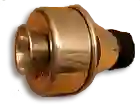Mute Wind instruments » Special playing styles » P. Dangas
Mute Wind instruments
The mute for wind instruments
The use of mutes on brass instruments is a very common technique. Dampers come in different sizes and designs. The mute is placed in the instrument's bell. A type of conical stopper with pieces of cork on the sides that allow it to fit into the bell. Without closing it completely.
Use of the mute for wind instruments and short description
- Horn:
- Horn players use either their right hand or commercially available mutes for muting.
- Trumpet:
- Damper with the largest selection. Due to the relatively small size of mutes, trumpeters can carry several different mutes.
- Trombone:
- Damper usable in several ways. But the most common use is the straight damper.
- Tuba:
- For them there is only one kind.
Classification of dampers according to their distinctive features
Trombones and trumpets
Dampers that deflect airflow
The airflow is forced to change its direction.
- Straight mute:
- the most common damper. When no other mute is required in the score, the trumpeters use this type of mute when marking "con sordino."
- Cap mute:
- More used in jazz. The timbre is more muted and darker than the straight mutes.
Dampers that absorb the air flow
The air flow is caught in a chamber and led out in different ways.
- Harmon Damper:
- A jazz mute, also known as a »wa-wa mute«. It is made of metal and has a rod inserted into the damper from the front. The sound quality can be muffled or it can be sharp and piercing.
- Solotone damper:
- Similar to the Harmon Damper but has a cardboard tube attached in the center. This amplifies the sound and gives it the typical megaphone quality.
Dampers that block airflow
After it has been produced, the sound is modified with a tool in front of the bell.
- Bucket mute:
- Looks like a bucket attached to the front of the horn. The sounds are generated with normal sound quality, but then "swallowed" by the bucket. This creates a horn-like timbre.
- Plunger:
- A bowl with a small handle held in front of the bell.
Mutes/wind instruments as part of the „symphonic world music“
The use of the dampers offers the reduction in sharpness. And the softer sound of wind instruments (depending on the type).
When the horn, the trombone and the trumpet blow piano, they can hardly be distinguished from each other in terms of sound. In such a case, the use of mute intensifies the "sound affinity." This allows brass instruments to be used where the overall tonal character could use a touch of color contrast.
Key data on the special type of Mute/Windinstruments
- Designation:
- Italian: „con sordino“
Deutsch: mit Dämpfer - Technology:
- The mute is placed in the instrument's bell.
- Result:
- Change in timbre from dull, dark and quiet to sharp and penetrating.
- Notation:
- »con sordino« Information about the staff.
Downloads for the Mute/Windinstruments - Score by Dmitri Shostakovich
Internal search function
| Name | Value | Delete |
|---|
